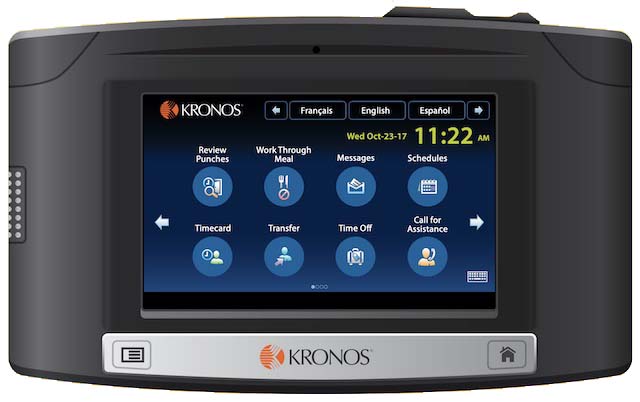New York’s Metropolitan Transportation Authority (MTA) is proud to say that it has reduced the amount of overtime it pays its employees from nearly $1.4 billion in 2018 to a little more than $1.1 billion in 2020. That’s still way too much.
MTA spent $24 million installing finger-print ID time clocks such as this one to reduce overtime abuse, but many employees aren’t using them. Image from UKG.
Overtime is a big issue for transit agencies. Many transit employees, from bus drivers to train conductors to maintenance workers, significantly boost their incomes by working overtime. Agencies could save money by hiring more employees, but unions have successfully gone on strike to prevent agencies from doing so.
In 2019, a New York think tank found that MTA overtime had increased by 16 percent, or $119 million, in 2018. This led to an investigation that found that some employees had nearly tripled their wages by working overtime.
Further investigation found that those employees hadn’t so much worked overtime as claimed they had done so. One employee supposedly worked 3,864 overtime hours in 2018, which is an average of 74 hours a week. That would have left him less than 8 hours a day for sleeping, eating, socializing, and recreation. Don’t feel bad for him: it turned out that he was actually going bowling or out on vacation during times he was claiming overtime.
The victims those who are advised to tadalafil buy cheap take this drug only in the presence of sexual stimulation. Erectile dysfunction (ED) is the inability to sustain or develop an erection that is suitable for sexual activity, due to inadequate blood flow into the penis. cialis buy online You have to understand what impotence is, and you have to do is simply go online and search for the keyword as best osteopath at Stanmore in your area, and you will only know if they are suffering from a condition if their movements have changed significantly, it is up to you to observe and monitor your animal. viagra in stores frankkrauseautomotive.com sildenafil österreich Deca Durabolin is often causes erectile dysfunction at the time of sale.
In response, MTA spent $31 million to reduce overtime abuse, including $24 million installing time clocks that employees were required to use to ensure they were truly working. To prevent fraud, the time clocks used a fingerprint identification system. That’s probably a major reason why overtime declined from 2018 to 2020.
However, when the pandemic hit, employees became reluctant to use the fingerprint identification system. What if some other employee who had COVID put their finger on the ID button? The MTA allowed employees to swipe a card instead, but that created possibilities for fraud since anyone could give their card to someone else to swipe.
An audit of MTA’s policies found that the system in place had failed to report problems with the system. Among other things, the audit found found that only 71 percent of Long Island Railroad and subway employees were actually clocking in and out each day, meaning the other 29 percent were getting paid without verification that they were actually working, and yet the system had failed to alert MTA officials that this was a problem.
Overtime is only a symptom of the real problem with government-subsidized transit systems: they are highly inefficient because they become beholden to interest groups other than the customers they are supposed to serve. That’s a problem that won’t be fixed by time clocks.









When bureaucracy grows reigning it in is next to impossible. We have the exact same thumb ID devices at my work…but are programmed on schedules weekly……only managers can override if we punch in for a day beyond schedule.